 |
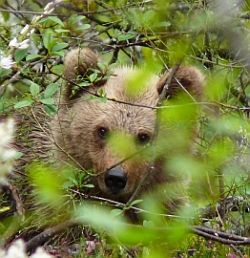 Cantabrican Brown Bear Ursus arctos© Fundación Oso Pardo Cantabrican Brown Bear Ursus arctos© Fundación Oso Pardo
Somiedo in Spring
Observing Cantabrican Brown Bears in Western Asturias, against a backdrop of superb scenery and a rich spring flora and fauna
Lying towards the western end of the Cordillera Cantábrica, the Somiedo parque natural is a remarkable enclave of deciduous and evergreen forest, herb-rich pastures and glorious haymeadows. Straddling precipitous river gorges, and liberally studded with jagged limestone outcrops, Somiedo houses one of the principal nuclei of Brown Bears in Spain. Over the past decade, concerted efforts by the Fundación Oso Pardo (Brown Bear Foundation) – in conjunction with statutory conservation bodies and the local farmers – have resulted in a substantial increase in the number of bears using the park, with recent estimates standing at 35 to 40 individuals.
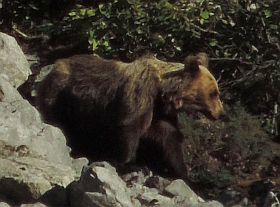 Cantabrican Brown Bear Ursus arctos© Teresa Farino Cantabrican Brown Bear Ursus arctos© Teresa Farino
This tour will be run in collaboration with the Fundación Oso Pardo (FOP), whose wardens closely monitor the movements of the various bears within the Somiedo park, as well as in the nearby Villablino enclave, on the southern flanks of the Cordillera Cantábrica. Throughout the week, one or more FOP wardens will accompany our party on all the morning and evening watches, as well as giving us advice as to the best spots to observe other wildlife in and around Somiedo. This arrangement will not only give us the best possible chance of viewing bears in the wild, but will also allow us to learn more about the biology and behaviour of these magnificent plantigrades from the recognised experts.
In a departure from previous years, this spring visit is designed to coincide with the emergence from hibernation of the mother bears with their young cubs. Whereas in autumn the localities in which bears are usually observed are very specific, resulting in congregations of more than 100 people on occasion, in spring the bears are likely to be found in a much wider range of sites, resulting in more 'intimate' stake-out conditions.
 Alpine Newts Mesotriton alpestris© Teresa Farino Alpine Newts Mesotriton alpestris© Teresa Farino
However, in such beautiful surroundings it would be criminal just to concentrate on the bears and ignore everything else, so in between intensive bouts of bear-watching, particularly at dawn and dusk (when they are most active), we will be exploring the different habitats in and around Somiedo in search of some of the park's other notable flora and fauna.
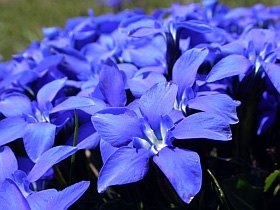 Spring Gentian Gentiana verna© Teresa Farino Spring Gentian Gentiana verna© Teresa Farino
Some of the more eyecatching flowering plants we are likely to encounter in May are Spring Gentians, the north-Iberian endemic anemone Anemone pavoniana and Purple Saxifrage in the limestone rock gardens, Hollowroot, Baneberry and Common Wintergreen in the forests and up to 20 species of orchids in the haymeadows, growing together with Violet Mountain Pansy, Wood and Bloody Crane's-bills, Aconite-leaved Buttercup and drifts of Narcissus pseudonarcissus.
Birdwise, apart from the ubiquitous Griffon Vultures, other raptors we might encounter include Egyptian Vulture, Red Kite, Booted and Short-toed Eagles, Goshawk, Hobby and Peregrine Falcon. Among the smaller birds, we should be able to locate Crag Martin, Short-toed Treecreeper, Firecrest, Iberian Chiffchaff, Serin and Rock and Cirl Buntings.  Rock Bunting Emberiza cia© Teresa Farino Rock Bunting Emberiza cia© Teresa Farino
In the high mountains we must keep an eye out for Water Pipit, and Red-billed and Alpine Choughs, and we might also be lucky to spot Rufous-tailed Rock Thrush, Alpine Accentor, Wallcreeper or Snowfinch. Somiedo's cascading streams and rivers hold good numbers of Grey Wagtails and White-throated Dippers, while Black Woodpeckers breed in the most remote forests.
Of the other wild mammals that inhabit Somiedo, we might also encounter Wildcats, Common Genets, Wild Boar, Southern Chamois and possibly even Wolves. Almost all the western European forest mustelids maintain good populations in the park, while the numerous mountain watercourses are home to Otters and Pyrenean Desmans. Castroviejo's Hare – endemic to upland scrub habitats in the Cordillera Cantábrica – and Snow Vole are the most noteworthy montane mammals of Somiedo.
Reptiles and amphibians of particular interest in the park include a number of species whose world distribution is restricted to western Iberia: 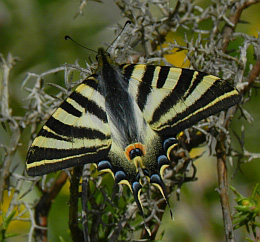 "Scarce Swallowtail "Scarce Swallowtail
Iphiclides podalirius feisthamelii© Teresa FarinoGolden-striped Salamander, Bosca's Newt, Iberian Frog,Schreiber's Green, Iberian Rock and Bocage's Lizards and Seoane's Viper. Equally beguiling are more widespread reptiles such as Ocellated and Viviparous Lizards and Southern Smooth Snake, with other amphibians we should be keeping an eye out for including Fire Salamander, Alpine Newt and Midwife Toad.
Given decent weather, good numbers of butterflies should be on the wing, including both Swallowtail and Scarce Swallowtail, Red-underwing, Lulworth and Mallow Skippers, Cleopatra, Berger's Clouded Yellow, Wood White, Sooty Copper, Turquoise, Adonis and Long-tailed Blues, Geranium Argus, Queen of Spain, Knapweed and Weaver's Fritillaries, and possibly even the last of the over-wintering Camberwell Beauties.
As part of our commitment to bear conservation in Spain, we shall be purchasing a year's membership subscription to the Fundación Oso Pardo for all tour participants, providing they agree to this on the booking form.
"That was one of the best holidays ever - I just cannot get over how lovely seeing the bears was - I never thought we would see them so often and so many. It was such a wonderful area - and so Brits-free which is bad for the Bear Foundation but great for us; hotel fine - food ditto." Virginia B. October 2013 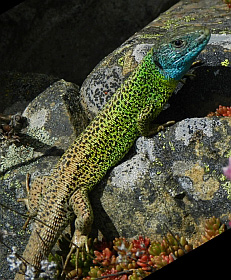 Male Schreiber's Green Lizard Male Schreiber's Green Lizard
Lacerta schreiberi © Teresa Farino
Spring in Somiedo
Leaders: Teresa Farino and wardens of the FOP
2016 Dates: Sunday 8 May – Sunday 15 May
Price: 1,380€, including half-board, en suite accommodation at the comfortable, family-run Casa Mińo, picnic lunches, hired minibus transport throughout, all entry fees and the services of the leader. A single-room supplement of 145€ is applicable. Although the cost of the tour is given in euros, clients may pay in sterling, the exchange rate to be calculated at the time of payment using www.oanda.com.
This is a land-based tour. Flights and travel insurance (obligatory) are the responsibility of the client.
Pick-up details: On 8 May, Teresa will be meeting easyJet flight EZY3083, which departs London Stansted at 10.25 and arrives in Asturias at 13.20. On 15 May, we shall be travelling back to Asturias airport in plenty of time to catch easyJet flight EZY3084, which departs at 13.55 and arrives back in Stansted at 14.45.
Alternatively, those travelling to Somiedo independently can arrange to meet the group at Casa Mińo on the first evening.
Group size: maximum 8 persons.
Booking information: please contact Teresa Farino for further details and a booking form, or if you have any queries about this tour.
| E-mail: |
|
|
| Office phone: | (+34) 942 735154 |
| Mobile phone: | (+34) 656 337129 |
|
| Address: |
Apartado de Correos 59
39570 Potes
Cantabria
Spain
|
|